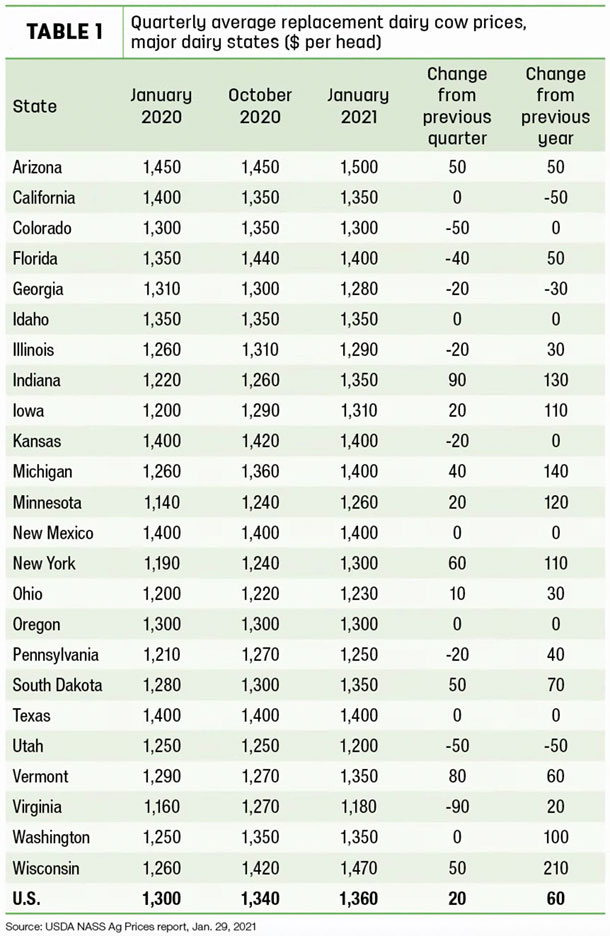Nationally, quarterly U.S. replacement dairy cow prices averaged $1,360 per head in January 2021, up $20 from October 2020 and about $60 more than January 2020. The U.S. average price was still 36% per head less than the latest peak of $2,120 in October 2014.
Compared to a year earlier, average prices were up in 15 of 24 major dairy states, down in three states and unchanged in six others (Table 1).

Latest USDA Milk Production reports indicate substantial year-to-year growth in cow numbers in Colorado, Idaho, Indiana, Michigan, Minnesota, New Mexico, South Dakota and Texas. Among those states, however, only Indiana, Michigan, Minnesota and to a lesser extent, South Dakota, saw much movement upward in replacement cow prices. Year-over-year price changes were flat in Colorado, Idaho, New Mexico and Texas. Wisconsin posted the largest year-to-year increase, even though the dairy herd there has been steady to shrinking.
On a quarterly basis, Indiana saw the largest jump in replacement cow prices compared to last October, up $90 per head. The biggest decline was in Virginia, down $90 per head. Highest January 2021 average prices were in Arizona and Wisconsin; lowest average prices were in Virginia and Utah.
The USDA estimates are based on quarterly surveys (January, April, July and October) of dairy farmers in 24 major dairy states, as well as an annual survey (February) in all states. The prices reflect those paid or received for cows that have had at least one calf and are sold for replacement purposes, not as cull cows. The report does not summarize auction market prices.
Cull cow prices improve
With fewer dairy cows headed to slaughter, prices for cull cows improved a little in 2020, the first year-to-year increase since 2013-14. 2020 average prices for cull cows (beef and dairy cows combined) rose to $65.27 per hundredweight (cwt), up $2.98 from 2019 but still the third-lowest average since 2010.
2021 starts with more cows, fewer heifers
The USDA’s semiannual estimate of cattle inventories indicates there were more dairy cows but fewer replacement heifers to start the new year.
As of Jan. 1, 2021, U.S. dairy herds contained about 9.44 million dairy cows that calved in 2020, up about 97,800 from a year earlier and the highest total since 1995.
Combined, dairy herds in Texas, Indiana, South Dakota, Michigan and Colorado had 89,000 more cows than a year earlier. In contrast, herds in Vermont, California, Florida and Pennsylvania were down a combined 19,000 head from Jan. 1, 2020.
Looking at potential replacements, there were about 4.605 million dairy heifers weighing 500 pounds or more, down 79,500 from a year earlier and the lowest number to start a year since 2014. That averages out to be about 48.8 heifers per 100 cows, the smallest ratio since 2009.
Of the dairy replacement heifers, 2.916 million head are expected to calve in 2021, down about 55,500 from 2021. As of Jan. 1, 2021, there were 30.9 replacements expected to calve for every 100 cows currently in the herd, the smallest percentage since 2004.
The inventories are based on data compiled by the USDA from about 34,900 dairy and beef operations during the first half of January.
(Detailed statistical analysis of state and national dairy herds and milk production will be featured in the April 1, 2021, issue of Progressive Dairy.) ![]()
-
Dave Natzke
- Editor
- Progressive Dairy
- Email Dave Natzke






